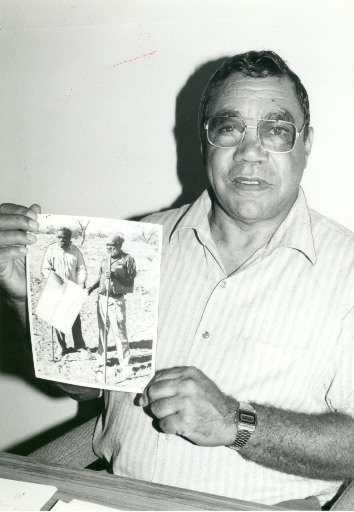2. Aborigines Free to Roam the Maralinga Test Site
Feb. 15, 2013
Chapter 3: The Central, South Pacific and Australia
Part 4: Britain’s Forgotten Legacy
Part 4: Britain’s Forgotten Legacy
The area of land around the Maralinga test site that was returned to the Aborigines in 1984 is approximately 130 miles square. Responsible for the administration of the land as well as assisting returnees is the Maralinga Tjarutja Land Holding Body, located in the town of Ceduna, South Australia, 150 miles southwest of Maralinga. We visited their offices and spoke to the chief administrator, Archie Barton.
"We really have no idea how many Aborigines were living in the area at the time of the testing, let alone how many were exposed to radiation," he said with a touch of resignation.
Barton showed us a black-and-white photo of two elderly Aborigines whom he suspected may have wandered into the test area by mistake, although he had no conclusive evidence. He explained to us the difficulty, of getting such evidence.
"The residents of this area didn't even know what a nuclear test was, so hardly any of them remember where they were or what they were doing at the time. The government put up warning signs, but not all the people here can read. There were people living close to the site totally unaware of the danger; it's extremely hard for us to tell who was exposed to radiation."
In 1984 the Australian government set up a committee to investigate possible cases of exposure, but was only able to prove conclusively that four Aborigines had received large doses of radiation. These four were a family who had been discovered wandering lost in the test area by army personnel. Even this incident had been kept secret for a long time, according to Barton.
The family, consisting of mother, father, and two children, accompanied by two dogs, entered the Maralinga site on the night of May 13, 1957. They stumbled into one of the craters created by the testing, and were discovered the next morning. The crater was still contaminated after a test conducted five months previously.
They were taken to the base, where they were checked for radiation and made to take decontamination showers several times. The same day they were driven to the Yalata compound 120 miles to the south. Low levels of radiation had been detected in their bodies, but not enough, it was decided, to have any adverse effects on their health. However, the child that the mother was carrying at the time was stillborn.
Barton told us, "This episode shows just how easy it was to enter the test site. The government didn't take enough care to ensure the safety of Aborigines living in the desert, and they can't deny it."
The mother of the family is still alive and well. At present she is seeking compensation from the Australian government on the grounds that it approved British plans to conduct nuclear tests without taking enough care to protect the local people.
The Aborigines have been on the retreat since Europeans first settled in Australia in the latter half of the eighteenth century. Deprived of their ancestral lands, the population, estimated at five hundred thousand at the time of the Europeans' arrival, dropped drastically to a low of fifty thousand in the 1930s. Aboriginal civil rights were finally recognized in 1967, and their numbers have recovered to an estimated two hundred thousand at the present time. Even so, there is no doubt that the confiscation of their land for use as a nuclear testing site has served to hasten the decline of the Aboriginal culture. The traditional life-style based on hunting and the village community is already in ruins, according to Barton. His main task at present is providing basic foodstuffs for those returning to the area.
The government acknowledges that Aborigines of the Great Victoria Desert may have suffered from contamination, but does not seem inclined to find out who they are. At present the committee has adopted a policy of carrying out investigations, but only if an Aborigine makes a claim first. The vast majority of Aborigines, however, are not even aware that they may have been exposed to radiation, so few claims are likely to be made.







